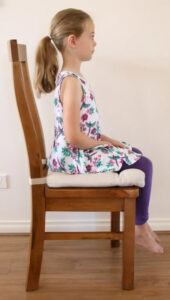For most of us, sitting up straight requires conscious effort. It is often mentally and physically easier to slouch.
Sitting up straight requires a certain amount of flexibility and some muscle strength, both of which can be achieved by most people with regular practice. If a person does not regularly attempt to actively sit up straight they may lose their sitting ‘fitness’, making it more difficult for them to sit up straight.
Encourage your child to actively sit up straight every day with their sternum (breast bone) raised and forward (see first image below). When they do this correctly they should feel their body weight pushing on the chair under their thighs. The more a child practices this the easier it should get. Good times to encourage upright sitting habits are at the dinner table (for the whole family), sitting on the sofa and when at their desk.

Top Tip – Attach a foam rubber block to the chair back for support.
When a child transitions to an adult sized chair but no longer uses a booster seat, their thigh bone is often not long enough to properly fit the chair (visible in the image above). When their knees are bent there can be a considerable gap between their back and the ‘chair’ back. The foam block should minimise the amount of slouching that occurs when your child chooses to relax back into their chair (see image below). I purchased this one from Clark Rubber. It is moderately dense foam and I chose a thickness to match the gap between the child’s bottom and the chair back when the child sits as far back as their knees allow. Change to a thinner foam block as your child grows. It is affixed with large elastic straps (from a hardware store).

Disclaimer: The information in this article is general in nature and is not intended as a substitute for professional help or advice. Neither Sure Start Chiropractic nor any of its practitioners assume any responsibility for harm or injury to anyone who uses the information, or damage to any equipment. If you or your child appears to be in pain or discomfort stop the activity and consider discussing this with a spine health professional.





